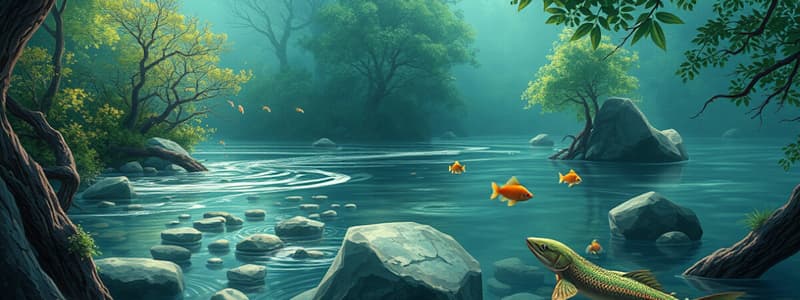Podcast
Questions and Answers
What are the primary factors contributing to the biodiversity found in river ecosystems?
What are the primary factors contributing to the biodiversity found in river ecosystems?
The primary factors include the variety of habitats provided by rivers, such as wetlands and floodplains, and the availability of resources for different species.
Explain how rivers play a role in food chains and food webs.
Explain how rivers play a role in food chains and food webs.
Rivers support food chains by providing producers, like algae and aquatic plants, which are then consumed by herbivores, leading to predators at higher trophic levels.
Discuss the impact of human activities on river ecosystems.
Discuss the impact of human activities on river ecosystems.
Human activities such as urban development, pollution, and damming disrupt river ecosystems, negatively affecting water quality and wildlife populations.
What is the significance of tributaries in a river system?
What is the significance of tributaries in a river system?
Describe the concept of a river basin and its importance in water resource management.
Describe the concept of a river basin and its importance in water resource management.
Identify where the source of the longest river is typically located and its significance.
Identify where the source of the longest river is typically located and its significance.
Flashcards are hidden until you start studying
Study Notes
Longest River in the World
River Ecosystems
- Biodiversity: Major rivers host diverse ecosystems, providing habitats for various species of fish, birds, mammals, and plants.
- Aquatic Life: Rivers support different aquatic habitats, such as wetlands and floodplains, crucial for spawning and feeding.
- Food Chains: Rivers are vital components of food webs, where producers (like algae and aquatic plants) support herbivores and predators.
- Human Impact: Urban development, pollution, and damming can disrupt river ecosystems, affecting water quality and wildlife.
- Conservation: Efforts to protect river ecosystems include sustainable management practices and habitat restoration.
River Sources and Tributaries
- Source: The longest river in the world typically has its source in highlands or mountain ranges, where precipitation collects.
- Main Stem: The primary channel of the river that flows towards its mouth, combining waters from various tributaries.
- Tributaries: Smaller rivers and streams that flow into the main river, contributing additional water and nutrients.
- Importance: Tributaries increase the river’s flow and biodiversity, often creating rich ecosystems along their banks.
- River Basin: The entire area of land drained by the river and its tributaries, important for managing water resources and flood control.
- Geographical Variability: The sources and tributaries of the longest river can span multiple countries, influencing regional hydrology and ecosystems.
River Ecosystems
- Major rivers host biodiverse ecosystems, providing habitats for various species including fish, birds, mammals, and plants.
- Rivers support different aquatic habitats like wetlands and floodplains, essential for spawning and feeding activities.
- They play a crucial role in food chains, where primary producers such as algae and aquatic plants support herbivores, which in turn support predators.
- Human activities such as urban development, pollution, and damming negatively impact river ecosystems, leading to degraded water quality and loss of wildlife.
- Conservation measures include sustainable management practices and habitat restoration to protect river ecosystems.
River Sources and Tributaries
- The longest river typically originates in highlands or mountain ranges, where precipitation accumulates and forms the source.
- The main stem is the primary channel that directs flow towards the river's mouth, integrating waters from various tributaries.
- Tributaries are smaller streams that feed into the main river, enhancing its flow and contributing additional nutrients to the ecosystem.
- These tributaries increase river biodiversity, creating rich ecosystems along their banks and supporting a variety of life forms.
- A river's basin encompasses all land drained by the river and its tributaries, playing a critical role in water resource management and flood control.
- The sources and tributaries of the longest river can span multiple countries, impacting regional hydrology and ecosystems significantly.
Studying That Suits You
Use AI to generate personalized quizzes and flashcards to suit your learning preferences.




